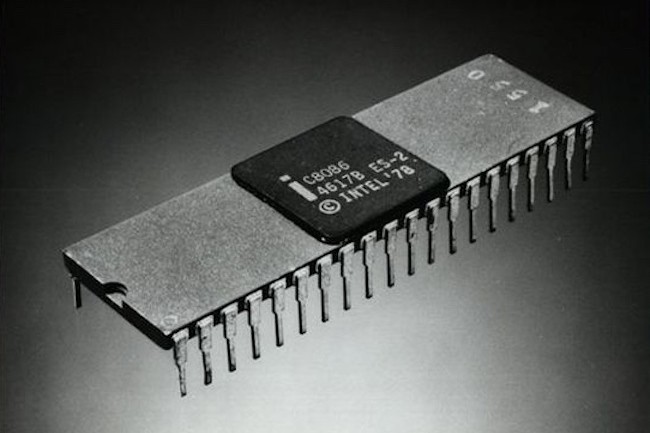

| Année | Nom | Nombre de transistors |
Finesse de gravure (nm) |
Nombre de cœurs | Fréquence de l'horloge | Largeur des données |
MIPS |
|---|---|---|---|---|---|---|---|
| 1971 | 2 300 | 10 000 | 1 | 740 kHz | 4 bits/4 bits bus | 0,06 | |
| 1974 | 6 000 | 6 000 | 1 | 2 MHz | 8 bits/8 bits bus | 0,64 | |
| 1979 | 29 000 | 3 000 | 1 | 5 MHz | 16 bits/8 bits bus | 0,33 | |
| 1982 | 134 000 | 1 500 | 1 | 6 à 16 MHz (20 MHz chez AMD) | 16 bits/16 bits bus | 1 | |
| 1985 | 275 000 | 1 500 | 1 | 16 à 40 MHz | 32 bits/32 bits bus | 5 | |
| 1989 | 1 200 000 (800 nm) | 1 000 à 800 | 1 | 16 à 100 MHz | 32 bits/32 bits bus | 20 | |
| 1993 | 3 100 000 | 800 à 250 | 1 | 60 à 233 MHz | 32 bits/64 bits bus | 100 | |
| 1997 | 7 500 000 | 350 à 250 | 1 | 233 à 450 MHz | 32 bits/64 bits bus | 300 | |
| 1999 | 9 500 000 | 250 à 130 | 1 | 450 à 1 400 MHz | 32 bits/64 bits bus | 510 | |
| 2000 | 42 000 000 | 180 à 65 | 1 | 1,3 à 3,8 GHz | 32 bits/64 bits bus | 1 700 | |
| 2004 | Pentium 4 D (Prescott) | 125 000 000 | 90 à 65 | 1 | 2,66 à 3,6 GHz | 32 bits/64 bits bus | 9 000 |
| 2006 | Core 2 Duo (Conroe) | 291 000 000 | 2 | 2,4 GHz (E6600) | 64 bits/64 bits bus | 22 000 | |
| 2007 | Core 2 Quad (Kentsfield) | 2*291 000 000 | 65 | 4 | 3 GHz (Q6850) | 64 bits/64 bits bus | 2*22 000 (?) |
| 2008 | Core 2 Duo (Wolfdale) | 410 000 000 | 45 | 2 | 3,33 GHz (E8600) | 64 bits/64 bits bus | ~24 200 |
| 2008 | Core 2 Quad (Yorkfield) | 2*410 000 000 | 4 | 3,2 GHz (QX9770) | 64 bits/64 bits bus | ~2*24 200 | |
| 2008 | Intel Core i7 (Bloomfield) | 731 000 000 | 45 | 4 | 3,33 GHz (Core i7 975X) | 64 bits/64 bits bus | 82 300 |
| 2009 | Intel Core i5/i7 (Lynnfield) | 774 000 000 | 45 | 4 | 3,06 GHz (I7 880) | 64 bits/64 bits bus | 76 383 |
| 2010 | Intel Core i7 (Gulftown) | 1 170 000 000 | 6 | 3,47 GHz (Core i7 990X) | 64 bits/64 bits bus | 147 600 | |
| 2011 | Intel Core i3/i5/i7 (Sandy Bridge) | 1 160 000 000 | 32 | 4 | 3,5 GHz (Core i7 2700K) | 64 bits/64 bits bus | 393 216 |
| 2011 | Intel Core i7/Xeon (Sandy Bridge-E) | 2 270 000 000 | 32 | 4 à 6 | 3,5 GHz (Core i7 3970X) | 64 bits/64 bits bus | 1 ou 2M |
| 2012 | Intel Core i3/i5/i7 (Ivy Bridge) | 1 400 000 000 | 4 à 6 | 3,5 GHz (Core i7 3770K) | 64 bits/64 bits bus | ||
| 2013 | Intel Core i3/i5/i7 (Haswell) | 1 400 000 000 | 22 | 4 à 6 | 3,8 GHz (Core i7 4770K) | 64 bits/64 bits bus | |
| 2014 | Intel Core i3/i5/i7 (Broadwell) | 1 400 000 000 | 4 à 10 | 3,8 GHz (Core i7 5775R) | 64 bits/64 bits bus | ||
| 2015 | Intel Core i3/i5/i7 (Skylake) | 1 750 000 000 | 14 | 4 à 8 | 4 GHz (Core i7 6700K) | 64 bits/64 bits bus | |
| 2016 | Intel Core i3/i5/i7 (Kabylake) | ? | 14 | 4 | 4,2 GHz (Core i7 7700K) | 64 bits/64 bits bus | |
| 2017 | Intel Core i3/i5/i7 (Coffee Lake) | ? | 14 | 6 | 5,0 GHz (Core i7 8086K) | 64 bits/64 bits bus | |
| 2019 | Intel Core i3/i5/i7 (Coffee Lake) | ? | 14 | 8 | 5,0 GHz (Core i7 9900KS) | 64 bits/64 bits bus | |
| 2019 | Intel Core i3/i5/i7/i9 (Ice Lake) | ? | 10 | 4 | 4,1 GHz (Core i7-1068NG7) | 64 bits/64 bits bus | |
| 2019 | Intel Core i3/i5/i7/i9 (Tiger Lake) | ? | 10 | 4 | 5,0 GHz (Core i7-11375H) | 64 bits/64 bits bus | |
| 2020 | Intel Core i3/i5/i7/i9 (Comet Lake) | ? | 8 | 5,3 GHz (Core i9-10900K) | 64 bits/64 bits bus | ||
| 2021 | Intel Core i3/i5/i7/i9 (Rocket Lake) | ? | 14 | 8 | 5,3 GHz (Core i9-11900K) | 64 bits/64 bits bus | |
| 2021 | Intel Core i3/i5/i7/i9 (Alder Lake) | ? | 10 | 16 | 5,3 GHz (Core i9-12900K) | 64 bits/64 bits bus | |
| 2023 | Intel Core i3/i5/i7/i9 (Meteor Lake) | ? | 7 | ||||
| 2024 | ? | ? | 2 | ||||
| 2025 | ? | ? | 1,8 |